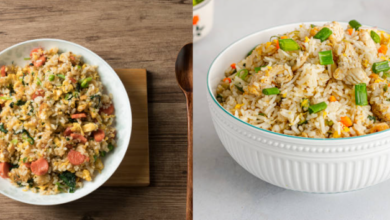Is fried rice supposed to be sticky? debunking the common misconception
What To Know
- In this blog post, we will explore the factors that influence the stickiness of fried rice and provide tips on how to achieve the desired texture.
- Long-grain rice, such as basmati or jasmine rice, tends to produce less sticky fried rice compared to short-grain rice, such as sushi rice or glutinous rice.
- To make your fried rice less sticky, use long-grain rice, add more oil, and fry the rice over high heat for a shorter period.
Fried rice is a beloved dish enjoyed by people worldwide, but one question that often arises is whether it should be sticky. The answer to this question depends on personal preference and the type of fried rice being made. In this blog post, we will explore the factors that influence the stickiness of fried rice and provide tips on how to achieve the desired texture.
What Determines the Stickiness of Fried Rice?
The stickiness of fried rice is primarily determined by the following factors:
1. Type of Rice: Long-grain rice, such as basmati or jasmine rice, tends to produce less sticky fried rice compared to short-grain rice, such as sushi rice or glutinous rice.
2. Amount of Oil: Adding more oil to the pan during cooking will result in less sticky rice. The oil acts as a lubricant, preventing the rice grains from sticking together.
3. Cooking Method: Frying the rice over high heat for a shorter period of time will produce less sticky rice. This method allows the rice grains to remain separate and prevents them from becoming mushy.
4. Seasonings: Adding certain seasonings, such as soy sauce or oyster sauce, can increase the stickiness of fried rice. These seasonings contain sugars and starches that bind the rice grains together.
Is Sticky Fried Rice Better Than Non-Sticky Fried Rice?
Whether sticky fried rice is better than non-sticky fried rice is a matter of personal preference. Some people enjoy the chewy texture of sticky rice, while others prefer the fluffier texture of non-sticky rice.
How to Make Non-Sticky Fried Rice
To make non-sticky fried rice, follow these tips:
1. Use long-grain rice: Choose a long-grain rice variety, such as basmati or jasmine rice.
2. Rinse the rice thoroughly: Rinse the rice several times with cold water until the water runs clear. This will remove excess starch, which can make the rice sticky.
3. Use a large pan: Cook the rice in a large pan or wok to prevent overcrowding and promote even cooking.
4. Fry the rice over high heat: Heat the pan over high heat and add a generous amount of oil. Add the rice and stir-fry constantly until the grains are separated and slightly toasted.
5. Season lightly: Add seasonings sparingly, as excessive seasoning can make the rice sticky.
How to Make Sticky Fried Rice
To make sticky fried rice, follow these tips:
1. Use short-grain rice: Choose a short-grain rice variety, such as sushi rice or glutinous rice.
2. Add less oil: Use a smaller amount of oil when frying the rice. This will allow the rice grains to stick together more easily.
3. Cook the rice over medium heat: Fry the rice over medium heat for a longer period of time. This will allow the rice grains to absorb more moisture and become sticky.
4. Season liberally: Add seasonings generously, such as soy sauce, oyster sauce, or sugar, to promote stickiness.
In a nutshell: Experiment and Find Your Perfect Texture
The ideal texture of fried rice is ultimately a matter of personal preference. Whether you prefer sticky or non-sticky fried rice, experimenting with different techniques and ingredients will help you find the perfect recipe that suits your taste buds. Enjoy the journey of culinary exploration and create delicious fried rice dishes that will delight your family and friends.
What You Need to Know
1. Why is my fried rice sticky?
Your fried rice may be sticky due to using short-grain rice, adding too much oil, or cooking the rice over low heat for an extended period.
2. How do I make my fried rice less sticky?
To make your fried rice less sticky, use long-grain rice, add more oil, and fry the rice over high heat for a shorter period.
3. Can I use instant rice to make fried rice?
Yes, you can use instant rice to make fried rice. However, it is important to note that instant rice may not produce the same texture as traditional rice.
4. What are some common seasonings used in fried rice?
Common seasonings used in fried rice include soy sauce, oyster sauce, sesame oil, garlic, ginger, and green onions.
5. Can I add vegetables to my fried rice?
Yes, you can add vegetables to your fried rice. Common vegetables used in fried rice include carrots, peas, broccoli, and bell peppers.
